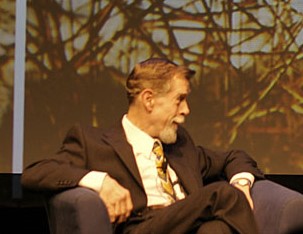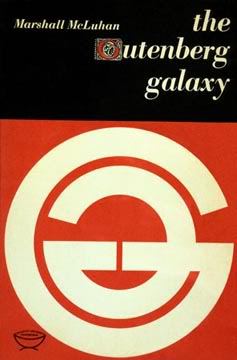The tetrad
The tetrad consists of four questions.
- What does the medium enhance?
- What does the medium make obsolete?
- What does the medium retrieve that had been obsolesced earlier?
- What does the medium reverse or flip into when pushed to extremes?
The laws of the tetrad exist simultaneously, not successively or chronologically, and allow the questioner to explore the "grammar and syntax" of the "language" of media. McLuhan departs from the media theory of Harold Innis in suggesting that a medium "overheats", or reverses into an opposing form, when taken to its extreme. [6]
Visually, a tetrad can be depicted as four diamonds forming an X, with the name of a medium in the center, where the left/right direction reflects the figure/ground association. The two diamonds on the left of a tetrad are the Enhancement and Retrieval qualities of the medium, both Figure qualities. The two diamonds on the right of a tetrad are the Obsolescence and Reversal qualities, both Ground qualities. [7]
- Enhancement (figure): What the medium amplifies or intensifies. For example, radio amplifies news and music via sound.
- Obsolescence (ground): What the medium drives out of prominence. Radio reduces the prominence of print and the visual.
- Retrieval (figure): What the medium recovers which was previously lost. Radio returns the spoken word to the forefront.
- Reversal (ground): What the medium does when pushed to its limits. Acoustic radio flips into audio-visual TV.

Herbert Marshall McLuhan was a Canadian philosopher whose work is among the cornerstones of the study of media theory. He studied at the University of Manitoba and the University of Cambridge. He began his teaching career as a professor of English at several universities in the United States and Canada before moving to the University of Toronto in 1946, where he remained for the rest of his life. He is known as the "father of media studies".

Media studies is a discipline and field of study that deals with the content, history, and effects of various media; in particular, the mass media. Media Studies may draw on traditions from both the social sciences and the humanities, but mostly from its core disciplines of mass communication, communication, communication sciences, and communication studies.

Harold Adams Innis was a Canadian professor of political economy at the University of Toronto and the author of seminal works on media, communication theory, and Canadian economic history. He helped develop the staples thesis, which holds that Canada's culture, political history, and economy have been decisively influenced by the exploitation and export of a series of "staples" such as fur, fish, lumber, wheat, mined metals, and coal. The staple thesis dominated economic history in Canada from the 1930s to 1960s, and continues to be a fundamental part of the Canadian political economic tradition.
Media ecology theory is the study of media, technology, and communication and how they affect human environments. The theoretical concepts were proposed by Marshall McLuhan in 1964, while the term media ecology was first formally introduced by Neil Postman in 1968.

Eric Marshall McLuhan was a communications theorist, son of Marshall McLuhan.

Understanding Media: The Extensions of Man is a 1964 book by Marshall McLuhan, in which the author proposes that the media, not the content that they carry, should be the focus of study. He suggests that the medium affects the society in which it plays a role mainly by the characteristics of the medium rather than the content. The book is considered a pioneering study in media theory.

The Gutenberg Galaxy: The Making of Typographic Man is a 1962 book by Marshall McLuhan, in which he analyzes the effects of mass media, especially the printing press, on European culture and human consciousness. It popularized the term global village, which refers to the idea that mass communication allows a village-like mindset to apply to the entire world; and Gutenberg Galaxy, which we may regard today to refer to the accumulated body of recorded works of human art and knowledge, especially books.

The Medium Is the Massage: An Inventory of Effects is a book co-created by media analyst Marshall McLuhan and graphic designer Quentin Fiore, with coordination by Jerome Agel. It was published by Bantam Books in 1967 and became a bestseller with a cult following. The U.K. edition was published by Allen Lane Penguin Books using cover art by Newsweek photographer Tony Rollo.
Robert K. Logan, originally trained as a physicist, is a media ecologist.
Old media, or legacy media, are the mass media institutions that dominated prior to the Information Age; particularly print media, film studios, music studios, advertising agencies, radio broadcasting, and television.

"The medium is the message" is a phrase coined by the Canadian communication theorist Marshall McLuhan and the name of the first chapter in his Understanding Media: The Extensions of Man, published in 1964. McLuhan proposes that a communication medium itself, not the messages it carries, should be the primary focus of study. He showed that artifacts such as media affect any society by their characteristics, or content.
Medium theory is a mode of analysis that examines the ways in which particular communication media and modalities impact the specific content (messages) they are meant to convey. It Medium theory refers to a set of approaches that can be used to convey the difference in meanings of messages depending on the channel through which they are transmitted. Medium theorists argue that media are not simply channels for transmitting information between environments, but are themselves distinct social-psychological settings or environments that encourage certain types of interaction and discourage others.

Monopolies of knowledge arise when the ruling class maintains political power through control of key communications technologies. The Canadian economic historian Harold Innis developed the concept of monopolies of knowledge in his later writings on communications theories.
Figure and ground is a concept drawn from Gestalt psychology by media theorist Marshall McLuhan in the early 1970s. This concept underpins the meaning of his famous phrase, "The medium is the message". The concept was an approach to what was called "perceptual organization." He began to use the terms figure and ground as a way "to describe the parts of a situation" and "to help explain his ideas about media and human communication." The concept was later employed to explain how a communications technology, the medium or figure, necessarily operates through its context, or ground.
Global village describes the phenomenon of the entire world becoming more interconnected as the result of the propagation of media technologies throughout the world. The term was coined by Canadian media theorist Marshall McLuhan in his books The Gutenberg Galaxy: The Making of Typographic Man (1962) and Understanding Media (1964). Literary scholar Sue-Im Lee describes how the term global village has come to designate “the dominant term for expressing a global coexistence altered by transnational commerce, migration, and culture”. Economic journalist Thomas Friedman's definition of the global village as a world “tied together into a single globalized marketplace and village” is another contemporary understanding of the term.

Lance A. Strate is an American writer and professor of communication and media studies at Fordham University. He was the 2015 Margaret E. and Paul F. Harron Endowed Chair in Communication at Villanova University, and in 2016 lectured at the School of Journalism and Communication at Henan University, in Kaifeng China.
This is a bibliography of Marshall McLuhan's works.
The Toronto School is a school of thought in communication theory and literary criticism, the principles of which were developed chiefly by scholars at the University of Toronto. It is characterized by exploration of Ancient Greek literature and the theoretical view that communication systems create psychological and social states. The school originated from the works of Eric A. Havelock and Harold Innis in the 1930s, and grew to prominence with the contributions of Edmund Snow Carpenter, Northrop Frye and Marshall McLuhan.

The Mechanical Bride: Folklore of Industrial Man (1951) is a study of popular culture by Marshall McLuhan, treating newspapers, comics, and advertisements as poetic texts.
In the social sciences, materiality is the notion that the physical properties of a cultural artifact have consequences for how the object is used. Some scholars expand this definition to encompass a broader range of actions, such as the process of making art, and the power of organizations and institutions to orient activity around themselves. The concept of materiality is used across many disciplines within the social sciences to focus attention on the impact of material or physical factors. Scholars working in science and technology studies, anthropology, organization studies, or communication studies may incorporate materiality as a dimension of their investigations. Central figures in the social scientific study of materiality are Harold Innis and Marshall McLuhan.










